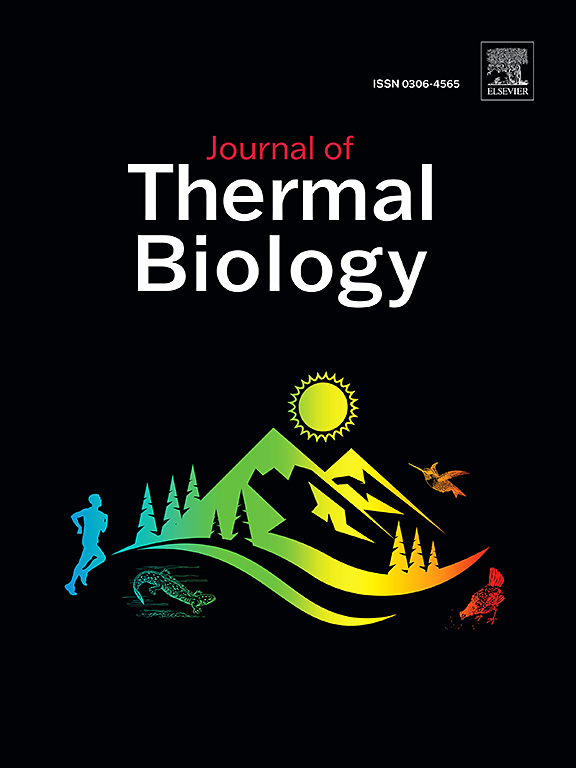用概念热平衡法探索耐热性测试中的偏差
IF 2.9
2区 生物学
Q2 BIOLOGY
引用次数: 0
摘要
全球气候变化增加了炎热天气的数量和强度,从而增加了劳累性中暑疾病的风险。热耐受性测试(HTT)是为了将遭受劳累性中暑的个人在恢复活动/工作之前分为耐热性或不耐热性。目前的分析旨在1 .检查HTT条件或措施内的潜在偏差;2。通过预测达到热平衡所需的排汗率(Sreq)来增强对HTT结果的解释。我们计算了热平衡方程的所有元素,包括使用Pandolf方程预测的代谢产热。计算了在体重(50 ~ 100 kg)、体重指数(18.5 ~ 30 kg⋅m−2)和风速(0 ~ 1.5 m⋅s−1)范围内实现热平衡的蒸发需水量、最大可能蒸发速率和Sreq。计算表明,基于代谢产热,直肠温度的变化似乎是判断耐热性的有效标准。然而,对皮肤湿润度的分析表明,在本研究中考虑的75%以上的情况下,HTT条件在生理上是不可补偿的。生理应变可能会因个体形态的不同而不同。因此,可能有必要确保HTT条件是可补偿的,以提高HTT特异性。最后,在测量和估计的Sreq之间存在显著偏差的情况下,Sreq的预测似乎是解释耐热性和改善医疗保健的有前途的工具。本文章由计算机程序翻译,如有差异,请以英文原文为准。
Exploring biases in heat tolerance testing with a conceptual heat balance approach
Global climate change increases the number and intensity of heat days, which increases the risk of exertional heat illness. The heat tolerance test (HTT) is performed to classify individuals who have suffered exertional heat stroke as heat tolerant or intolerant, prior to their return to activity/duty. The current analysis aimed to i. examine potential biases within the HTT conditions or measures; ii. enhance the interpretation of the HTT results through the prediction of sweat rate required to reach thermal balance (Sreq). We calculated all the elements of the heat balance equation including metabolic heat production that was predicted using the Pandolf equation. The evaporative requirement for heat balance, the maximum evaporative rate possible and Sreq were calculated for a range of body masses (50–100 kg), body mass indices (18.5–30 kg⋅m−2) and wind speeds (0–1.5 m⋅s−1). The calculations suggest that, based on metabolic heat production, the change in rectal temperature appears to be a valid criterion to judge heat tolerance. However, the analysis of skin wettedness reveals that the HTT conditions are not physiologically compensable for more than 75% of the scenarios considered in the present study. Physiological strain will likely differ depending on the morphology of individuals. Thus, it may be necessary to ensure that the HTT conditions are compensable to improve HTT specificity. Finally, the prediction of Sreq appears to be a promising tool for interpreting heat intolerance and improving medical care, in cases of significant deviation between measured and estimated Sreq.
求助全文
通过发布文献求助,成功后即可免费获取论文全文。
去求助
来源期刊

Journal of thermal biology
生物-动物学
CiteScore
5.30
自引率
7.40%
发文量
196
审稿时长
14.5 weeks
期刊介绍:
The Journal of Thermal Biology publishes articles that advance our knowledge on the ways and mechanisms through which temperature affects man and animals. This includes studies of their responses to these effects and on the ecological consequences. Directly relevant to this theme are:
• The mechanisms of thermal limitation, heat and cold injury, and the resistance of organisms to extremes of temperature
• The mechanisms involved in acclimation, acclimatization and evolutionary adaptation to temperature
• Mechanisms underlying the patterns of hibernation, torpor, dormancy, aestivation and diapause
• Effects of temperature on reproduction and development, growth, ageing and life-span
• Studies on modelling heat transfer between organisms and their environment
• The contributions of temperature to effects of climate change on animal species and man
• Studies of conservation biology and physiology related to temperature
• Behavioural and physiological regulation of body temperature including its pathophysiology and fever
• Medical applications of hypo- and hyperthermia
Article types:
• Original articles
• Review articles
 求助内容:
求助内容: 应助结果提醒方式:
应助结果提醒方式:


